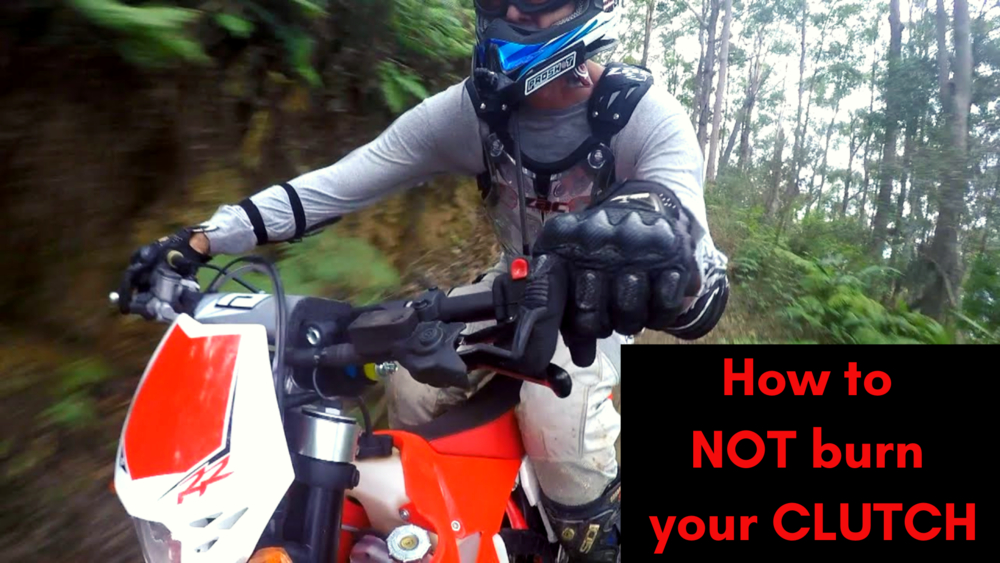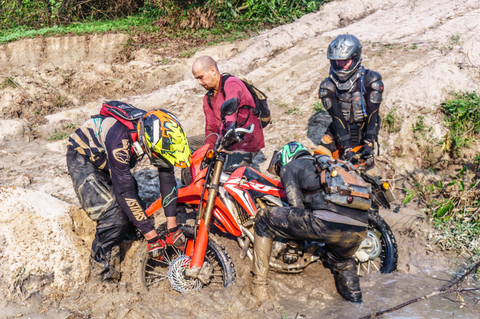
Burning the clutch on a motorbike is a surprisingly easy thing to do, especially on offroad motorbikes where people push themselves outside their comfort zones. Clutch plates wearing out is mostly driver error and can be avoided. Test driving clutch plate condition is easy. Clutch plates don’t really “wear with time” either, not in the context we are talking anyway.
Clutch plates have a sort of melting point, they get to a certain temperature and they give way. A clutch can take huge amounts of abuse, providing this melting point isn’t reached.
So how do we get to this melting point?
1. We get stuck in the mud and have no idea how to correctly get out.
2. We let the clutch lever position get too far into the finger tips which semi disengages it. ( no clutch play at all)
Stuck in the mud, driving like a retard and burn your clutch
You have probably seen this picture before, someone stuck in the mud, revinng the crap out of their motorbike and creating a chain saw sounding noise that can be heard from miles and miles away. If you are one of these people, then your clutch is going to die, the question is just how many minutes from now.
What we are seeing here, is a half-engaged clutch, because the rider is trying to raise the RPM to keep the bike from stalling, in order to spin the back wheel to get out of the situation. Constant abuse like this will have the clutch fried in no time. It doesn't matter what the original condition was.
Slipping the clutch - or clutch feathering - is a useful technique to get out of a difficult situation in technical terrain. However, know when to stop, or you will risk burning the clutch. Try to get more traction by decreasing the psi, put more weight onto the rear tire, and keep the momentum going to avoid getting stuck. If nothing works, it is worth getting off the bike and push.
Getting stuck in the mud can quickly spiral out of control, desperation sets in and more and more aggression and heat is put into revving the bike to get out of the tight spot. Relax, and reconsider your approach.
If you are a warrior who likes the high rev chain saw approach, then at the very least give the bike time to cool down between your failed efforts to escape the mud.
Adjusting the clutch lever too far out can cause a clutch burn
Customers are often used to hydraulic clutches and dislike free play in the clutch. Cable clutches should have free play and adjusting the clutch to the fingertips can lead to a situation of a semi disengaged clutch. This will burn the clutch, especially at high speeds.
To setup the clutch positioning, make sure there is some free play. To do this, Screw in the clutch positioning on your left hand. If you are unable to screw in far enough to get some free play, go to a mechanic and they can adjust it for you. Clip of adjusting it
If you have too much free play, you will find the motorbike doesn’t completely disengage the clutch and this will cause the bike to be difficult to change gears, especially in neutral. This is the main cause for drivers saying “the gearbox is old”. In reality, the clutch is set up badly.
To diagnose a worn-out clutch, drive the bike in any gear and the engine will rev high but the bike won’t engage properly. It will have no acceleration.
How does pro-riders cope with clutch wear?
Experienced riders, especially in the offroad world will use the clutch aggressively. It allows them to quickly get more or less power to the back wheel without changing gears. Mastery of the clutch is part of what changes an amateur rider into a good rider.
However, these riders will know and understand what they are doing Some riders for example “I am heavy on the clutch I need to replace it every x amount of months”.
If you are one of these riders who have begun to master and practice correctly slipping the clutch for power, then give the bike a break to cool down occasionally and use common sense to avoid the clutch melting point. These bikes can take a serious amount of abuse, but treat them with some respect.
Fixing the clutch
The good news is that replacing the clutch is very quick. A good mechanic can do it in around 30 minutes. The XR 150cc has the same clutch plates as the Honda Wave, so these can be found in any Honda store throughout Vietnam and you can quickly be on your way again.
Above 150cc motorbikes, unfortunately, rely on Tigit sending the parts to your destination. Once the part arrives it is a quick job for any mechanic.
Clutch plates vary between 500k and 3 million VND. It depends on the quality of the part used and the model of the bike. Also, Some mechanics will just swap out the broken plate, other mechanics will swap out the entire set. Sometimes mechanics find other small damages within the system and will do quick fixes. It is best to just pay up and be on your way again! Clutch plates on these manual motorbikes is not a routine job for any mechanic in Vietnam so they charge what they feel their time is worth.
Things to take away from this
- Clutches don’t randomly break over time. They fail rapidly, we are talking just minutes of bad driving to wipe out a clutch.
- Test drive the bike at pickup, if the clutch is good, then it will last your journey.
- When you get stuck in the mud and burn the clutch. Learn from the situation and try to avoid letting it happen again!
- Keep an eye out on your clutch leaver positioning and don’t let it get too far into your fingertips.


























Log In